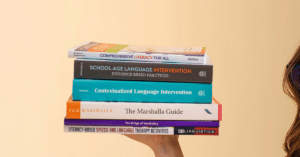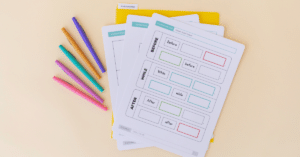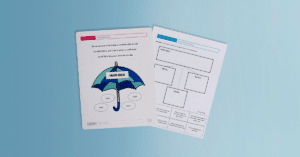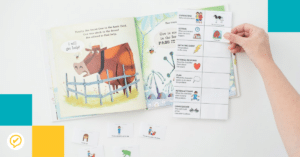You know that Johnny is struggling with vocabulary. He scored below the 4th percentile on subtests, including vocabulary. His teacher says that he struggles to learn new words and that it is having a significant impact on his progress in the classroom.
Where in the world do we start?
It feels like we’re already so far behind. Typically developing children learn new words at an incredible rate. Will we ever be able to catch up?
Either way, we want to make sure that we’re setting the right goal and implementing strategies that will give him the most gains. We want to make as much meaningful change as possible.
After all, the “right” goal or strategy can have an incredible impact.
If we make the “right decisions,” Johnny will make more rapid progress. He’ll be able to start participating in the classroom more quickly. He may even be able to “catch up”–no longer needing special education services.
On the other hand, the “wrong” goal or strategy can have the opposite impact.
Johnny will make slower progress. He’s more likely to fall behind and continue to need special education services. He’ll miss more time in the classroom and will have less of a chance to “catch up” as time passes.
Now, that is a little dramatic. 🙂 It definitely doesn’t boil down to one decision. We do want to make sure we’re making the best decisions we possibly can. Every decision we make as clinicians has an impact.
Now, if that isn’t overwhelming, then I don’t know what is!
That’s why we’re starting this series on vocabulary intervention.
Let’s dive into the research so we can start wrapping our heads around all of this! Let’s arm ourselves with knowledge so we can make the best possible decisions for our students.
We are going to be discussing a variety of articles over the next several weeks, but let’s dive into one framework to get us started.
It comes from this article:
The authors “identified 34 rigorous experimental studies (published between 1988 and 2014) of book-reading interventions that directly raised children’s vocabulary and determined what strategies (or, in many cases, combinations of strategies) explained children’s vocabulary gains.”
One caveat: The authors presented these strategies to teachers. I will list the five strategies the authors identified, but I will share the research I found that will help us apply this to a therapeutic context. (The authors did include some articles/studies that focused on students with language delays/disorders.)
That said, we don’t have an abundance of research to direct what we do in therapy (especially when it comes to broader frameworks). This article was one of the most helpful ones I found; however, we still need to think critically. How does this apply to your students? If you are going to apply these strategies, then how can you make sure they’re working?
In order to make that step easier, I will share articles that support the use of these strategies in a therapeutic context with students of different ages.
Also… Why the focus on literacy? You all know that I love literacy-based therapy! If we have to select therapy targets anyway, then it seems logical to choose targets that are related to the student’s context. Check out these blog posts for a review of the research and “how to’s” related to this type of therapy.
Now let’s jump in…
1. Define New Words
This first step of the framework is to define new words for students!
Students with special needs often struggle to learn words indirectly and benefit from direct teaching of new vocabulary targets (Pence & Justice, 2016).
2. Discuss New Words (Ask Questions)
Engaging in discussion gives the student the opportunity to engage with the word in a meaningful way. This also gives us the opportunity to target other goals. That’s a win for those of us who work with mixed groups!
Note: If you’re looking for a more general framework, check out this article by Marzano. This is also geared towards teachers, but the suggestions can still apply to students on our caseloads!
3. Reread
The authors point out that rereading books gives students additional exposure to target words in meaningful contexts.
Students with delays/disabilities need more exposures. The average child needs 15 meaningful exposures for a word to become automatic (Marzano, 2004). Children with language impairment need more exposures (Pence & Justice, 2016).
4. Retell
“Retelling supports vocabulary learning because, like rereading, it increases children’s exposure to and use of new words and concepts in a story” (Snell, Hindman, & Wasik, 2015). Three studies in the article found that retelling had a significant impact on word learning.
Note: It’s okay to think outside of the box. Encouraging students to play with words creates an interest in knowing more about them (e.g., word consciousness), which is essential to vocabulary growth (Stahl, 1999). A retell doesn’t have to be a verbal recount of a story. We can re-enact the story, use visuals, etc. Anything that keeps students engaged will give us more bang for our buck. Here are four ideas to get you started.
These experiments included preschool and kindergarten students, but the concept can also apply to older students. It took a little bit of modification, but I used this with a group of 5th graders. The students had multiple opportunities to practice their targets in a meaningful context. Best of all? They retained the words and were able to use them in context! Scroll to the bottom of this post for a description of how this worked.
5. Integrate New Words into Activities
If we are teaching vocabulary being used in the classroom, then we already have a huge advantage. Check out the Lowman, Stone, & Guo (2018) article for one example of how to strategically select targets.
We will continue discussing how to select words for intervention. We’ll also be sharing more activity ideas over the next several weeks.
Whew! That’s a lot, isn’t it?
The good news is that we’ll continue to break this down together!
Enter your name and email below to follow this series! We’ll send you a weekly email (and a bonus resource) to help you implement these vocabulary strategies with your caseload!
References
Pence, K. L., & Justice, L. M. (2016). Language development from theory to practice. Upper Saddle River, NJ: Pearson Education. (Affiliate Link)
Stahl, S.A. (1999). Vocabulary development. Cambridge: Brookline. (Affiliate Link)






Leave a Reply